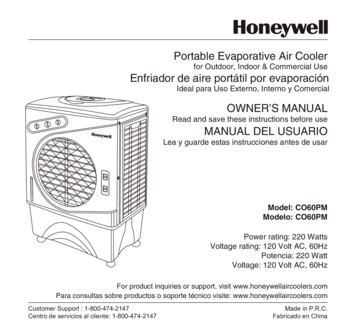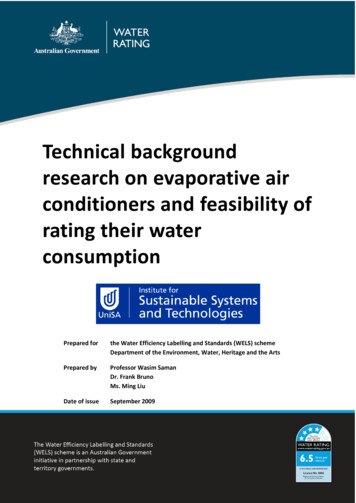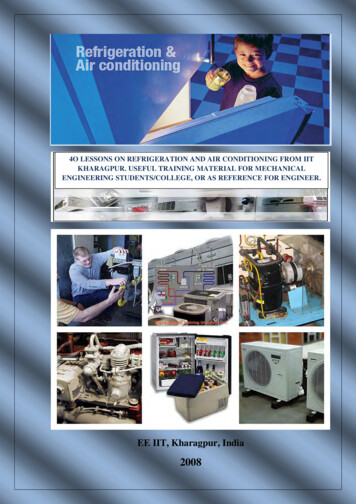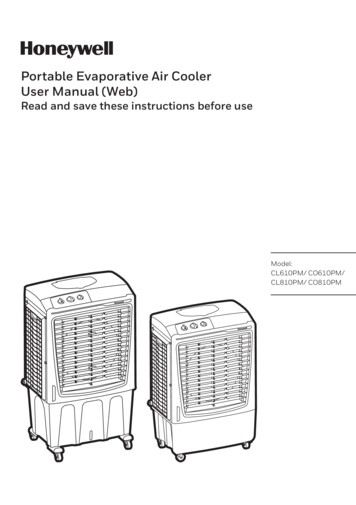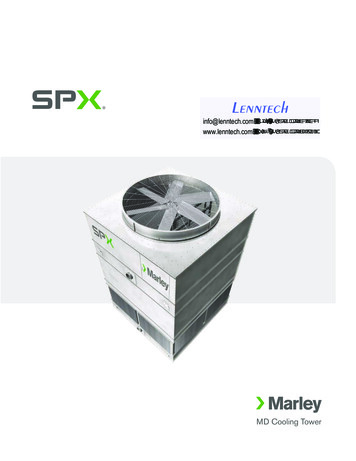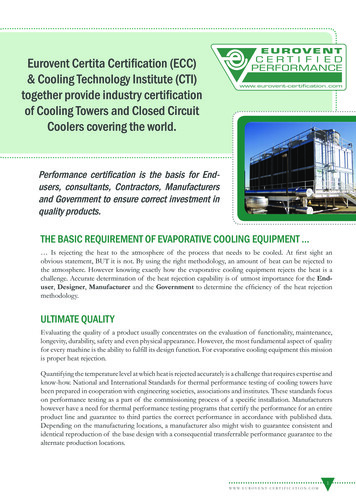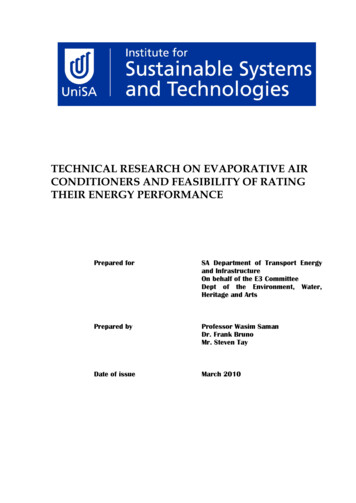
Transcription
TECHNICAL RESEARCH ON EVAPORATIVE AIRCONDITIONERS AND FEASIBILITY OF RATINGTHEIR ENERGY PERFORMANCEPrepared forSA Department of Transport Energyand InfrastructureOn behalf of the E3 CommitteeDept of the Environment, Water,Heritage and ArtsPrepared byProfessor Wasim SamanDr. Frank BrunoMr. Steven TayDate of issueMarch 2010
1
ContentsExecutive Summary .41. Product Profile .61.1 Types of evaporative air conditioners. 61.2 Suitability for use in Australia. 111.3 Market share of evaporative air conditioners. 141.4 Types of heating systems. 151.4.11.4.21.4.31.4.41.4.51.4.6Reverse Cycle Air Conditioners . 15Ground Coupled System . 17Gas Heating . 17Wood Heating . 18Solar Heating . 20Hydronic Heating . 201.5 Energy consumption of evaporative air conditioners . 211.5.1 Cooling effects and energy used . 211.5.2 Estimates of energy consumption of cooling capacity of energyconsumption in different parts of Australia . 221.6 Energy consumption of the components of evaporative airconditioners. 252. Regulatory Approaches . 262.1 Australian standards. 262.2 International regulations and standards. 262.3 Standard test conditions . 292.4 Shortcomings of current standards . 293. Testing/Rating Method . 303.1 Review of available energy consumption testingprocedure/methodology. 303.2 Development of a test methodology. 303.3 Proposed test conditions. 323.4 Proposed parameter for rating energy performance . 323.5 Application of the proposed testing and rating procedures to newtechnologies. 334. Performance Evaluation Information . 344.1 Development of information for rating/labelling. 344.2 Proposed information for rating/labelling. 344.3 A parameter for rating the energy performance of evaporative airconditioners. 352
4.4 Example of the calculation of SEER. 364.5 Procedure for evaluation of the rating of the energy, coolingcapacity and comfort performance parameters. 365. Conclusions and recommendations . 38References . 39Appendix 1: Available Evaporative Air Conditioners in Australia & Their KeySpecifications . 40Appendix 2: Raw Air Conditioner Data in Figs 6 & 7 (ABS data). 47Appendix 3: Energy Consumption in a Typical Adelaide Hot Day . 49Appendix 4: Energy Consumption in a Typical Adelaide Summer Day. 51Appendix 5: Industry Contact List . 53Appendix 6: Glossary of terms . 543
Executive SummaryThe installation of mechanical air conditioning appliances has become a normal requirementin almost all new and existing Australian dwellings. While the use of refrigerated airconditioners have been rapidly increasing, the market share of evaporative air conditionershas witnessed a steady decline and currently makes up less than 20% of the installed systemsin Australian dwellings. Domestic air conditioning has considerable impact on energy use andpeak power demand. Evaporative air conditioners generally consume less energy but requirewater for their operation.This report will build on the information provided by a previously completed initial report bythe authors (Saman and Bruno, 2008). The report was discussed by industry Commonwealthand State Government representatives in a workshop held on June, 2008. The proposed worktakes into consideration feedback received from the workshop participants and aims toimplement some of the recommendations put forward by the report and agreed upon by theworkshop participants.In developing a draft methodology for rating the energy performance of evaporative coolers,it has been proposed previously that the process should be carried out alongside a parallelprocess being instigated for rating the water consumption of evaporative coolers andincorporating them in the Water Efficiency Labelling Scheme (WELS). The development of acombined procedure for rating both energy and water consumption has been recommended ina report recently submitted by the authors (Saman, Bruno and Liu, 2009). This reportincorporates and updates some of the information gathered in the previous reports on the sizeand features on the evaporative air conditioning market.The report includes available information on energy consumption of evaporative airconditioners and calculations of typical energy consumption and performance of evaporativeair conditioners in different Australian locations. The results highlight the suitability of usingevaporative air conditioners in most Australian locations except in the hot humid regions. Thereport also demonstrates the sensitivity of the cooling capacity and energy consumption to theair moisture content.This report also reviews currently available local and international regulations and standardsfor testing, labelling and rating evaporative air conditioners. The California ApplianceEfficiency Regulations include a procedure for evaluating and rating the energy performanceof evaporative air conditioners. Iran is the only country that currently conducts a mandatorycomparative labelling program for energy consumption of evaporative air conditioners. Aproposed test and evaluation methodology for rating energy performance is put forward. It isproposed that independent testing should be carried out alongside water consumption testingusing a single test facility. The report sets out a detailed proposed procedure for carrying outstandard testing of evaporative air conditioners to evaluate their energy consumptioncharacteristics. The proposed testing procedure supplements the current Australian StandardsAS/NZS 2913-2000.The report proposes the use of a new location specific ―Seasonal Energy Efficiency Ratio‖ asthe key parameter for evaluating the energy performance of evaporative air conditioners. Thisparameter can be evaluated through calculations based on the standard test results and theannual temperature and humidity variations for a typical year. Based on the test andcalculation results, it also proposes the evaluation of a number of other parameters which will4
characterize comfort provision, cooling capacity energy use and cost for tested systems. Theseparameters will provide useful information to consumers, manufacturers/suppliers andgovernments. As the performance of evaporative air conditioners, is dependant on localtemperature and humidity patterns, these parameters can be evaluated by computer modelingfor all main Australian locations. An interactive computational tool has been developed toevaluate the key cooling capacity, comfort and energy consumption parameters for majorcities in Australia with the input data being the results of the proposed testing methodology.Early consultation with manufacturers, suppliers and users groups is considered to be animportant step in progressing a labelling/rating system for energy and water use inevaporative air conditioners. A technical study for further developing a standard testprocedure, testing facilities and methodology for independent testing, rating/labelling of bothwater and energy use in evaporative air conditioners, as well as modifying the current teststandard to provide for this, is also recommended.5
1. Product Profile1.1 Types of evaporative air conditionersThe utilisation of water evaporation for cooling purposes has its origins well entrenched inhistory. Evidence of evaporative cooling applications by ancient people of the Middle East iswidely documented and some of these applications are still in use in the Middle East today.They include the use of porous water vessels, the wetting of pads made of dried vegetableswhich cover the doors and windows facing the prevailing wind and directing the prevailingwind into pools of running water in underground rooms (Saman, 1993). Early Australians alsoused different forms of evaporative air cooling to obtain some comfort in the hot dry climatesof outback Australia.Direct evaporative air conditioning is ideal for arid climates where water is available. Thedirect evaporative air conditioners currently produced have, by and large, overcome thedrawbacks associated with older systems. In addition to more efficient fan and duct designsand control systems, the use of plastics for the bodywork, cellulose and other syntheticmaterials for the pads together with automatic water bleeding or flushing has resulted in morereliable operation with little maintenance. Many of today‘s evaporative air conditioners havequite sophisticated control systems with variable air speeds and pad wetting rates. The oneremaining inherent drawback associated with direct cooling is the water saturation limitinherent in the process. Even with saturation efficiency over 80%, which is common formany modern systems, the air supplied may not provide cooling comfort if the outside airtemperature is high and/or its moisture content is high and close to saturation with watervapour. The lowest possible temperature limit attained by direct evaporative cooling is thewet bulb temperature at which the delivered air is fully saturated with moisture.Evaporative air conditioners can be categorised as direct, indirect, two- and multi-stage.Direct evaporative air conditioners are the most popular in the market. As shown in Fig.1 (a),outside air is drawn through wetted filter pads, where the hot dry air is cooled and humidifiedthrough water evaporation. The evaporation of water takes some heat away from the airmaking it cooler and more humid. The dry-bulb temperature of the air leaving the wetted padsapproaches the wet-bulb temperature of the ambient air. Direct evaporative air conditionersare more effective in dry climates. As they produce warmer, more humid air in comparisonwith refrigerated air conditioners, considerably more air volumes are required to produce thesame cooling effect. The cool/humid air is used once and cannot be reused. Evaporation(saturation) effectiveness is the key factor in determining the performance of evaporative airconditioners. It is defined by Eqn.1. This property determines how close the air beingconditioned is to the state of saturation. Usually, the efficiency is 85-95% (ASHRAEHandbook, 2007).e100t1t2t1t'(1)Where direct evaporation (saturation) efficiency, %ot dry-bulb temperature of entering air, Cot dry-bulb temperature of leaving air, Cot ' wet-bulb temperature of entering air, Ce126
FANFANFANFigure 1: Types of evaporative air conditioners: (a) direct; (b) indirect & (c) two-stage combined(Wang et al., 2000).The saturation efficiency also has an impact on water consumption. Increased saturationeffectiveness is associated with higher water consumption. However, as higher saturationeffectiveness produces conditioned air at lower temperatures, the overall impact of havinghigher saturation effectiveness is usually an improved energy and water consumption per unitcooling output.Indirect evaporative air cooling is shown in Fig.1(b).The principle of operation of indirectevaporative cooling is the use of cool air produced by direct evaporative cooling (secondaryair stream shown in Fig. 1(b)) to cool another air stream which is used for space cooling bythe use of a heat exchanger. As cooling of the primary air stream takes place by heat transferacross the heat exchanger walls without the mixing of the 2 air streams, the primary air streambecomes cooler without an increase in its humidity. Indirect evaporative air conditioners areeffective in regions with moderate/high humidity. Indirect evaporative cooling effectiveness isdefined in Eqn.2. According to manufacturers‘ rating, this effectiveness ranges from 0.6-0.80(ASHRAE Handbook, 2004).iet1t2t1ts(2)'Whereie indirect evaporative cooling effectiveness7
dry-bulb temperature of entering primary air, oC dry-bulb temperature of leaving primary air, oC wet-bulb temperature of entering secondary air, oCt1 t2t s'Two stage or indirect/direct evaporative air conditioners combine both direct and indirectevaporative principles. In two-stage evaporative air conditioners, the first stage (indirect)sensibly cools the primary air (without increasing its moisture content) and the air isevaporatively cooled further in the second stage (direct) as shown in Fig.1(c). The dry-bulbtemperature of the supplied primary air can be reduced to 6 K or more below the secondaryair wet-bulb temperature (ASHRAE Handbook, 2004) without adding too much moisture. Astwo-stage evaporative coolers produce lower temperatures, they consequently require less airdelivery in comparison with the direct systems. Heidarinejad et al. (2009) experimentallystudied the cooling performance of two-stage evaporative cooling systems under the climateconditions of seven Iranian cities. It has been found that the saturation efficiency (as definedin equation 1 above) of the indirect/direct evaporative air conditioner varies in a range of108 111%. Also, over 60% energy can be saved using this system compared to a vapourcompression system. However, it consumes 55% more water in comparison with directevaporative cooling system for the same air delivery rate. Monitoring the electricityconsumption of evaporative and conventional refrigerated cooling systems in a smallcommercial building has demonstrated considerable energy savings and improved thermalcomfort with evaporative cooling (Saman, et al. 1995). Indirect evaporative cooling can alsobe used as a component of multistage air conditioning systems which may also includerefrigerated cooling stages. In such cases, the indirect evaporative cooling may be sufficientfor the provision of typical summer cooling requirements. The refrigerated stage operation islimited to peak demand days.Indirect evaporative air conditioners have been gaining more popularity in the market inrecent years. Recently, both Seeley International and Clear Solar have started marketingindirect evaporative air conditioners. Seeley has been developing such air conditioners for anumber of years. Clear Solar is marketing a product developed in USA by Coolerado.Both products produce air at conditions closer to refrigerated systems. Unlike conventional airconditioning units, they use no ozone-depleting chemicals and have mainly one energyconsuming component, the fan. The heart of both systems which sets them apart fromconventional evaporative coolers is a unique wetting system, a modular heat and massexchanger and the way the air flows through it.In 2008, Coolerado received a grant to build a solar-powered mobile demonstration coolerwhich brought Coolerado to the attention of a broader audience. The unit is outfitted with fourPV panels to power the cooler, and the cooler helps the solar array run at a lower temperatureand hence improved efficiency by about 15%.Seeley has drawn together its most innovative and energy efficient technologies and mergedthem with what it has been developing behind the scenes, over the past 14 years. The result isClimate Wizard, a product that incorporates a patented revolutionary heat exchanger whichensures that no moisture is added to the air entering the conditioned space, and at the sametime it maximises the effectiveness of all of the elements necessary to best facilitate the heatexchange process.8
Climate Wizard delivers significantly colder air than can be achieved by traditionalevaporative cooling. It delivers air at temperatures near, and at times, below, those producedby refrigerated air conditioning. According to the manufacturer, Climate Wizard uses up to 54%less energy than a fixed speed refrigerated system. Based on independent testing by theUniversity of South Australia, Climate Wizard is able to provide pre-cooled ―make-up air‖ tolarge commercial refrigeration plants, resulting in energy savings of up to 35%, and at times,even more. A Slim-line version for domestic applications, designed for installation against theouter walls of homes, has approximately the same footprint as a water heater. Air is deliveredthrough the space between the outer wall and the roof into the home and then through aconventional ducting system in the ceiling space, and into the rooms of homes. Ducting andfittings are the same dimensions as for traditional refrigerated systems.The main focus of this report is direct evaporative air conditioners as most units in current usewithin Australia are of this variety. However, the scope of the report also includes indirect andtwo-stage systems in view of their recent entry into the Australian market.A direct evaporative air conditioner is an enclosed metal or plastic box with louvers on thesides containing a fan or a blower with an electric motor, a number of cooling pads, a watercirculation pump to wet the cooling pads and a float valve to maintain a proper water level inthe reservoir. Fig. 2 illustrates the components in a typical evaporative air conditioner.Figure 2: Schematic diagram of the components of a typical direct evaporative air conditioner.Types of evaporative air conditioners range from portable units, window/wall units andducted units for residential and commercial use. Portable units cool one room at a time. Theyare fitted with legs and wheels and can be moved easily from room to room. A small pump isutilized to keep the cooling pads wet and water is needed to be periodically filled manually inthe internal water storage tank. Typical portable evaporative air conditioners are shown inFig.3. However, this report only examines plumbed units/systems and therefore the portable9
units will be excluded from the discussion. Window/wall evaporative air conditioners aremounted through exterior windows or walls and they can cool larger areas than the portableunits. A window evaporative unit is presented in Fig. 4. Ducted evaporative air conditionersmake up the vast majority in use in Australia. They are usually mounted on the roof and thecooled air is delivered through ducts to each room in the building. Fig. 5 shows residentialroof ducted evaporative air conditioners with different profiles. Both window/wall and ductedunits have a water bleeding system to control the water salinity under a certain level.Figure 3: Portable evaporative air peac/ConvairPEAC.html).10
(b)(c)(a)Figure 4: (a) Window evaporative air conditioner; (b) View from cooled space; (c) View from ing/window/default.aspx)Figure 5: Residential roof ducted evaporative air conditioners with different profiles.1.2 Suitability for use in AustraliaUsing the Australian summer design conditions, Tables 1 and 2 include the estimates of theperformance parameters of direct and indirect evaporative air conditioners. The parametersinclude the outlet temperature, relative humidity and cooling capacity for 8 Australianlocations.11
Table 1: Performance of direct evaporative air conditioners at some Australian locationsAIRAHDesignConditionsAir conditionerSupplyConditionsCooling Capacity(kW)Based on10 000 m3/hrair flowDry Bulb( C)Wet Bulb( C)Dry BulbTemperature( .547.515.1Sydney31.119.821.561.818.8The first two columns of Table 1 show the AIRAH design conditions of the dry and wet bulbtemperatures for eight cities in Australia. The dry bulb temperatures of the air leaving thedirect evaporative air conditioner are presented in the third column. The temperatures of theair leaving the direct evaporative air conditioner can be calculated from Eqn. 1, based on theassumption that the saturation efficiency of the direct evaporative air conditioner is 85%. Therelative humidity of the air leaving the evaporative air conditioner is also included in the table.Based on a nominal volume flow rate of 10,000 m3/hr for the air conditioner, the coolingcapacity of the direct evaporative air conditioner is computed based on Eqn. 3 below. Table 1shows that despite the relatively low temperatures achieved by direct evaporative airconditioners, the low cooling capacity and high humidity produced in the tropical andsubtropical regions (Darwin, Brisbane) make their use impractical. However, comfort coolingconditions (temperature and relative humidity) and high cooling capacities are achievable inall other Australian locations having relatively cool and/or dry summers.One option for extending the climatic regions where evaporative cooling is effective is the useof indirect or 2 stage indirect/direct evaporative cooling. The use of a heat exchanger to coolthe outside air without humidifying it by making use of indirect evaporative cooling systemswas developed in Australia in the 1960s and 1970s; plate heat exchangers were manufacturedand marketed (Pescod, 1968 & Pescod, 1979). From the manufacturing view point, the mainchallenge of the system is the size and cost of the heat exchanger required to achieve goodeffectiveness and low pressure loss. Work has been done at the University of South Australia12
to develop low cost heat exchangers optimised for heat recovery as well as indirectevaporative cooling purposes (Saman & Kilsby, 1999).Both indirect evaporative air conditioners which have recently been introduced into theAustralian market are based on multistage indirect evaporative cooling and achieve lowertemperatures without increasing the air humidity, thus enabling them to compete directly withrefrigeration systems. Consequently less air is required for producing the required coolingcapacity in comparison with direct systems.Table 2: Performance of indirect evaporative air conditioners at some Australian locationsAIRAHDesignConditionsAir conditionerSupplyConditionsCooling Capacity(kW)Based on2 000 m3/hr air flowDry Bulb( C)Wet Bulb( C)Dry Bulb ( 46.2Sydney31.119.817.081.95.7The first two columns of Table 2 show the AIRAH design conditions of the dry and wet bulbtemperatures for eight major cities in Australia. The dry bulb temperature and relativehumidity of the air leaving the indirect evaporative air conditioner are presented in the thirdand fourth columns. The temperatures of the air leaving the indirect evaporative airconditioner is calculated from Eqn. 2, based on the assumption that the direct evaporativesaturation efficiency is 125%. With the wet and dry bulb temperatures of the air leaving theevaporative air conditioner determined, the relative humidity of the air leaving the evaporativeair conditioner can then be computed. Based on a reduced nominal volume flow rate of 2,000m3/hr, the cooling capacity of the indirect evaporative air conditioner is computed based onEqn. 3 below.13
1.3 Market share of evaporative air conditionersThere are currently four major local evaporative air conditioner manufacturers: Air GroupAustralia Pty Ltd, Carrier Australia Pty Ltd, Climate Technologies Pty Ltd and SeeleyInternational Pty Ltd. The evaporative air conditioners that are currently available in Australiatogether with their key available specifications (such as type, energy input, water bleedingsystem, fan and pad type, supply flow rate, control system and evaporation efficiency) arelisted in Appendix 1.Figure 6 shows the national penetration of air conditioners and the number of air conditioners(including refrigerated and evaporative) utilised in residential houses in Australia from 1994to 2008 (ABS, 2008). Penetration is the proportion of households having a particular type ofair conditioner. The refrigerated air conditioners refer to the reverse cycle and cooling onlyrefrigerated air conditioners, non-ducted or ducted. Between 1999 and 2008, there has been asharp increase in penetration and the number of refrigerated air conditioners. The penetrationrose from 34.7% in 1999 to 66.4% in 2008, which is nearly double in 10 years. The number ofevaporative air conditioners slowly increased from 0.41 million in 1994 to 1.03 million in2005, before slightly decreasing between 2005 and ion60.050.04.00040.03.00030.02.000Penetration (%)Units 00020022004200620080.02010YearFigure 6: National penetration and number of air conditioners (ABS, 2008)Fig. 7 illustrates some trends in the share of installed stock of air conditioners which are of theevaporative variety, both by state and nationally. The share of evaporative air conditionersreached a peak (27.4%) in 1999 and gradually went down to 18.6% in 2008. Also, for most ofthe states, the evaporative air conditioner share decreased since 1999. However, evaporativeair conditioners are still popular in suitable climatic zones – Western Australia, AustralianCapital Territory, Victoria and South Australia where their market share is around 30%.However, the general trend is a clear reduction of market share in the face of competitionfrom refrigerated systems. The raw data for Figs. 6 and 7 is listed in Appendix 2.14
Evaporative air conditioner share traliaFigure 7: Evaporative air conditioners percentage share of all installed domestic air conditioners bystate and nationally (ABS, 2008).Refrigerated air conditioner sales in Australia had a distinct increase over the past 25 yearsfrom less than 100,000 units per year in 1980 to more than 900,000 units a year in 2006(Energy Efficient Strategies, 2008). The market is large and complex and at present there arearound 200 brands. The vast majority of domestic refrigerated air conditioners are imported.The annual sales figure of rooftop evaporative air conditioners is approximately 60,000 unitsand this figure has been reasonably stable over the last 5 years. Most of the residential ductedevaporative air conditioners sold in Australia are manufactured domestically.Despite the lower energy consumption of evaporative air conditioners in comparison withother cooling systems, and improvements in the quality of products produced by theAustralian evaporative air conditioning industry, there is a general trend of a shrinking marketshare. This is partly possibly a result of the competition provided by internationalrefrigeration system manufacturers and suppliers, particularly in marketing their products, aswell as cost advantages associated with larger scales production.1.4 Types of heating systems1.4.1 Reverse Cycle Air ConditionersRefrigeration air conditioners shift heat from one location to another, using a compressor andtwo heat exchangers linked by a refrigeration circuit. As electricity is required to operate thecompressor and fans which take the heat from the environment, they are the most efficientform of electric heating. Unlike electrical resistance heaters which at most convert allelectrical input into heat (efficiency approach 100%), the heating output provided by a reversecycle air conditioner may be 3 to 6 times the electrical energy consumed by the system.Refrigeration air conditioners are available as ―cooling only‖ units, or ―reverse cycle units‖15
which provide both cooling and energy efficient heating. There are a number of differenttypes of refrigeration air conditioners available:window/wall units which are used for individual rooms or small open plan areas.non-ducted split systems which are used for individual rooms or small open plan areas.These differ to the above in that the 2 heat exchangers are separated, one being locatedindoors and the other outdoors.ducted systems (usually of the split type) which are used for large open plan areas or thewhole floor of a building.multi-split systems, which have more than one indoor unit with more than one independentindoor controls, with only one condenser unit located outside.chillers which cool water as opposed to air. The cold water is then piped around the hometo cool the air with the use of heat exchangers.
Evaporative air conditioners can be categorised as direct, indirect, two- and multi-stage. Direct evaporative air conditioners are the most popular in the market. As shown in Fig.1 (a), outside air is drawn through wetted filter pads, where the hot dry air is cooled and humidified through water evaporation.
